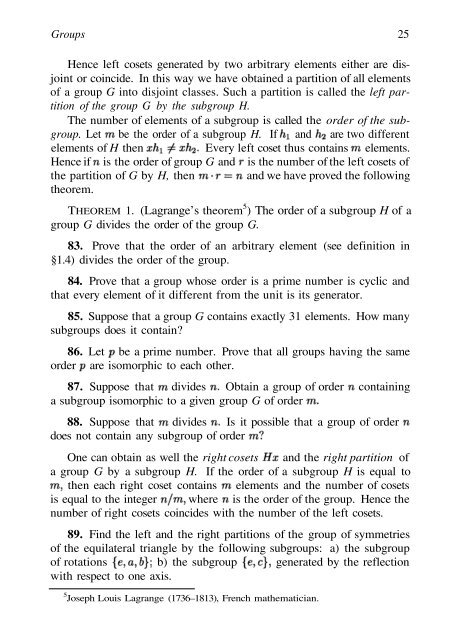Abel's theorem in problems and solutions - School of Mathematics
Abel's theorem in problems and solutions - School of Mathematics
Abel's theorem in problems and solutions - School of Mathematics
Create successful ePaper yourself
Turn your PDF publications into a flip-book with our unique Google optimized e-Paper software.
Groups 25<br />
Hence left cosets generated by two arbitrary elements either are disjo<strong>in</strong>t<br />
or co<strong>in</strong>cide. In this way we have obta<strong>in</strong>ed a partition <strong>of</strong> all elements<br />
<strong>of</strong> a group G <strong>in</strong>to disjo<strong>in</strong>t classes. Such a partition is called the left partition<br />
<strong>of</strong> the group G by the subgroup H.<br />
The number <strong>of</strong> elements <strong>of</strong> a subgroup is called the order <strong>of</strong> the subgroup.<br />
Let be the order <strong>of</strong> a subgroup H. If <strong>and</strong> are two different<br />
elements <strong>of</strong> H then Every left coset thus conta<strong>in</strong>s elements.<br />
Hence if is the order <strong>of</strong> group G <strong>and</strong> is the number <strong>of</strong> the left cosets <strong>of</strong><br />
the partition <strong>of</strong> G by H, then <strong>and</strong> we have proved the follow<strong>in</strong>g<br />
<strong>theorem</strong>.<br />
THEOREM 1. (Lagrange’s <strong>theorem</strong> 5 ) The order <strong>of</strong> a subgroup H <strong>of</strong> a<br />
group G divides the order <strong>of</strong> the group G.<br />
83. Prove that the order <strong>of</strong> an arbitrary element (see def<strong>in</strong>ition <strong>in</strong><br />
§1.4) divides the order <strong>of</strong> the group.<br />
84. Prove that a group whose order is a prime number is cyclic <strong>and</strong><br />
that every element <strong>of</strong> it different from the unit is its generator.<br />
85. Suppose that a group G conta<strong>in</strong>s exactly 31 elements. How many<br />
subgroups does it conta<strong>in</strong>?<br />
86. Let be a prime number. Prove that all groups hav<strong>in</strong>g the same<br />
order are isomorphic to each other.<br />
87. Suppose that divides Obta<strong>in</strong> a group <strong>of</strong> order conta<strong>in</strong><strong>in</strong>g<br />
a subgroup isomorphic to a given group G <strong>of</strong> order<br />
88. Suppose that divides Is it possible that a group <strong>of</strong> order<br />
does not conta<strong>in</strong> any subgroup <strong>of</strong> order<br />
One can obta<strong>in</strong> as well the right cosets <strong>and</strong> the right partition <strong>of</strong><br />
a group G by a subgroup H. If the order <strong>of</strong> a subgroup H is equal to<br />
then each right coset conta<strong>in</strong>s elements <strong>and</strong> the number <strong>of</strong> cosets<br />
is equal to the <strong>in</strong>teger where is the order <strong>of</strong> the group. Hence the<br />
number <strong>of</strong> right cosets co<strong>in</strong>cides with the number <strong>of</strong> the left cosets.<br />
89. F<strong>in</strong>d the left <strong>and</strong> the right partitions <strong>of</strong> the group <strong>of</strong> symmetries<br />
<strong>of</strong> the equilateral triangle by the follow<strong>in</strong>g subgroups: a) the subgroup<br />
<strong>of</strong> rotations b) the subgroup generated by the reflection<br />
with respect to one axis.<br />
5 Joseph Louis Lagrange (1736–1813), French mathematician.

















